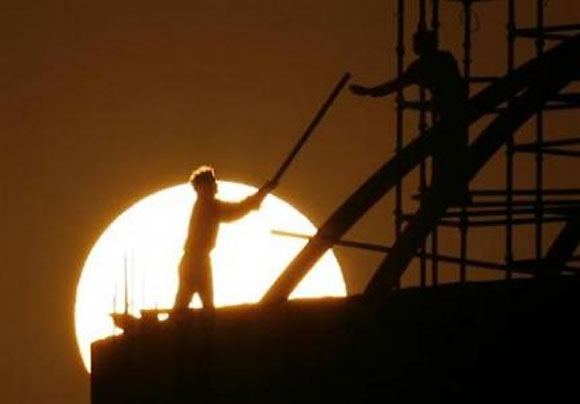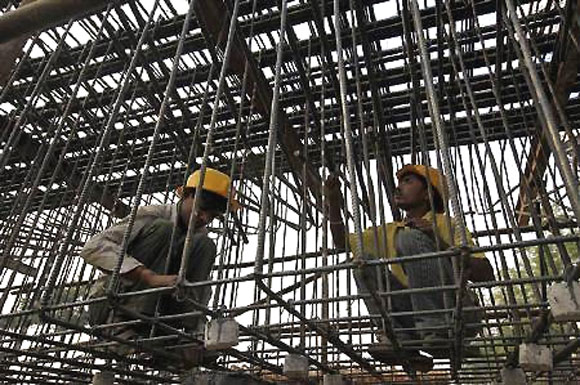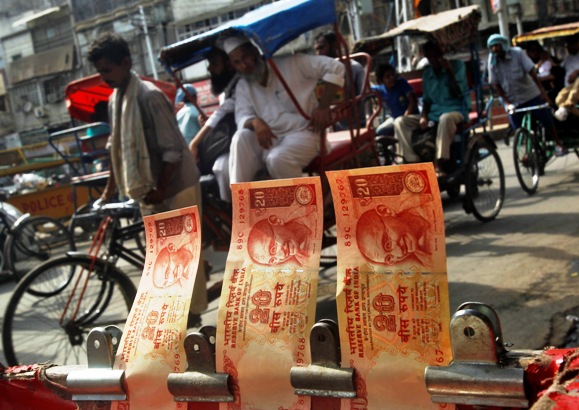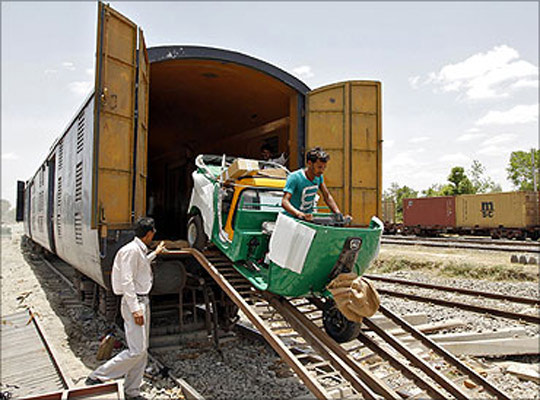Photographs: Adnan Abidi/Reuters T N Ninan
The industrial output numbers are particularly damning, averaging four per cent growth in the last five years, two per cent in the last two, and turning negative in the first few months of this year.
Have we regressed to a pre-reform era? Consider the following. The eight years and more since 2004-05 have seen a continuous non-oil trade deficit, the first such period since the 1980s - coincidentally, another period that saw overvalued exchange rates.
The overall current account deficit has trebled in the last four years, reaching levels that are now much higher than the pre-1991 crisis level of about three per cent of GDP. How have these deficits been financed?
Partly by piling up foreign debt. In March 2005, the country’s foreign exchange reserves were more than its total foreign debt; now debt is much the larger figure - as it was pre-1991.
...
UPA has 'managed' to take the economy back to the 80s
Photographs: Danish Siddiqui/Reuters
What is more, the ratio of short-term debt (repayable within a year) to reserves has doubled since 2005, from 27.5 per cent to 59 per cent - a massive uptick in external vulnerability that mimics the pile-up of short-term debt in the late 1980s.
What of the domestic situation? The absolute size of the central government’s fiscal deficit quadrupled in the five years to 2012-13 - averaging 5.6 per cent of GDP, up from 3.8 per cent in the previous five-year period (2003-08).
The performance of the latest quinquennium takes the country back to the preceding decade of 1993-03, when the fiscal deficit had averaged 5.8 per cent.
Inflation rates too hark back to an earlier period: the last five years have seen average consumer price inflation of 10.3 per cent, which compares with some of the most inflationary periods of the 1980s and 1990s.
...
UPA has 'managed' to take the economy back to the 80s
Photographs: Vivek Prakash/Reuters
The solutions being attempted – jacking up duties on gold and giving smuggling a boost, hiking tariffs on “luxury” imports, asking monetary policy to undo the damage done by fiscal policy – are all reminders of an earlier era.
The focus on “defending” the rupee is also familiar, but puzzling. The fact is that the rupee’s dollar value remained virtually unchanged in an entire decade. The exchange rate was 45.68 in 2000-01; 10 years later it was 45.58.
There is no other 10-year period in the last half-century when the nominal rupee-dollar rate remained unchanged. Given the macroeconomic trends (high inflation and growing trade deficits), it was obvious that the rupee had to fall, which it did - to 50 against the dollar by March 2012, 55 by March 2013, and now to about 61.
...
UPA has 'managed' to take the economy back to the 80s
Photographs: Anindito Mukherjee/Reuters
This is not a loss of national honour; the fall is basically a correction.
Meanwhile, growth in the 2011-14 triennium (and perhaps beyond) is likely to average about 5.6 per cent - a number that, like some other indicators, harks back to what prevailed in the 1980s.
The industrial output numbers are particularly damning, averaging four per cent growth in the last five years, two per cent in the last two, and turning negative in the first few months of this year.
Exports fell last year, and have fallen again in the first quarter of this year, while imports have continued to grow. Naturally, corporate sales and profit numbers are turning flat, and the main stock market indices are lower today than they were more than five years ago.
...
UPA has 'managed' to take the economy back to the 80s
Photographs: Anindito Mukherjee/Reuters
Inevitably, portfolio capital has begun flowing out these past couple of months. When there is $170 billion of short-term debt to be rolled over or repaid, and a current account deficit of at least $60 billion to be financed through capital inflows, the outflow of investor money is the latest danger signal, one that signals transition from problem to potential crisis.
Confidence has to be restored before a crisis actually occurs, that is before the reserves start getting depleted.
Last time round, we delayed going to the International Monetary Fund till we were nearly bankrupt, because an election was coming. So what will the “dream team” do now?







article